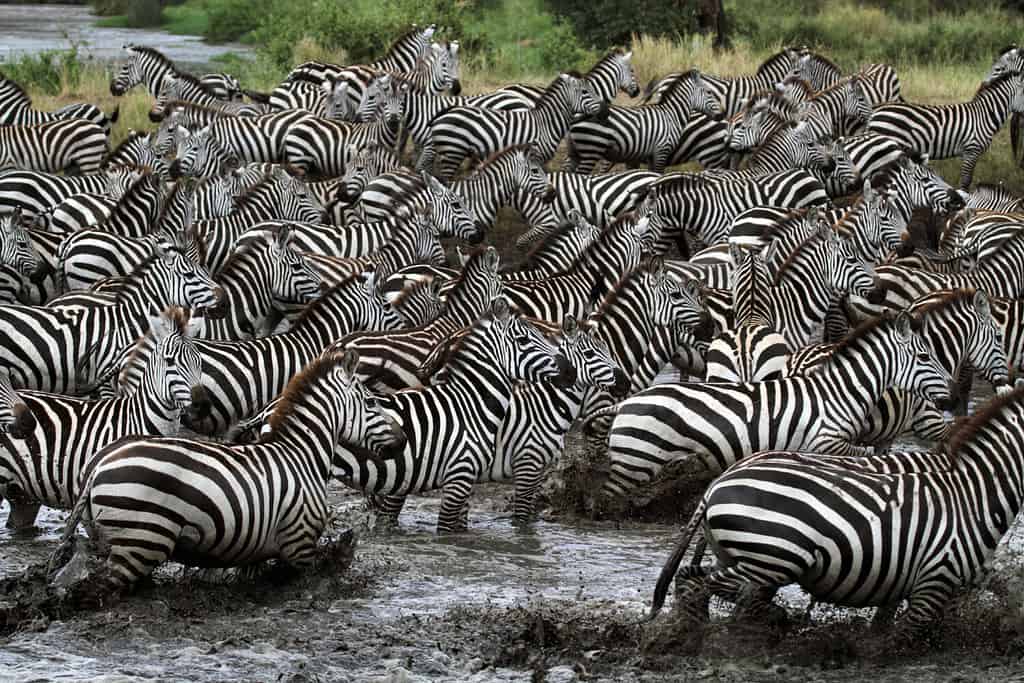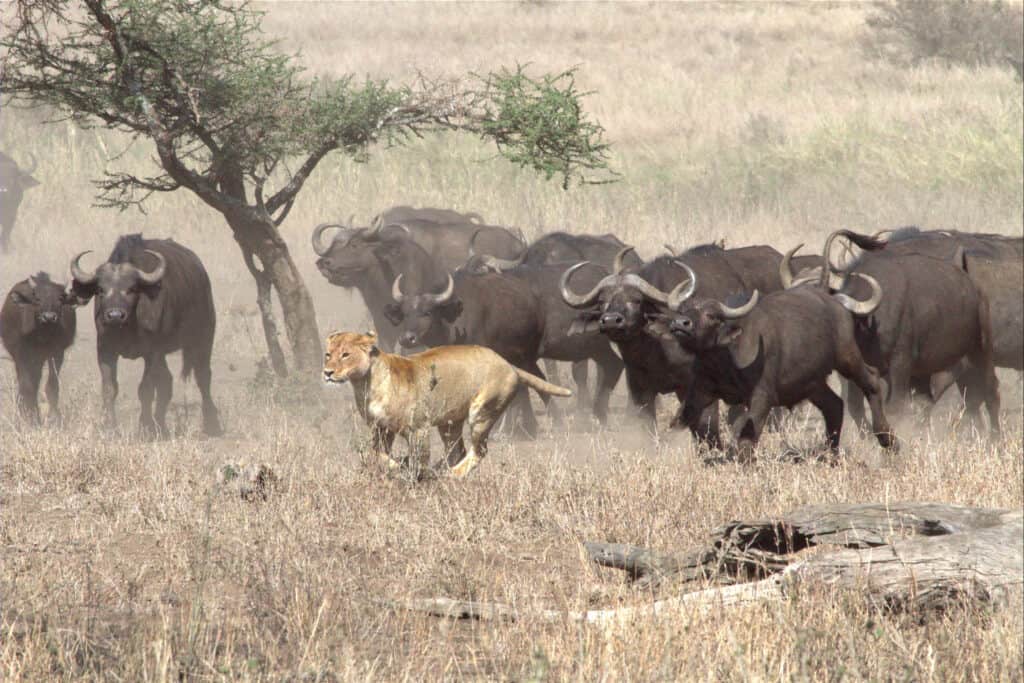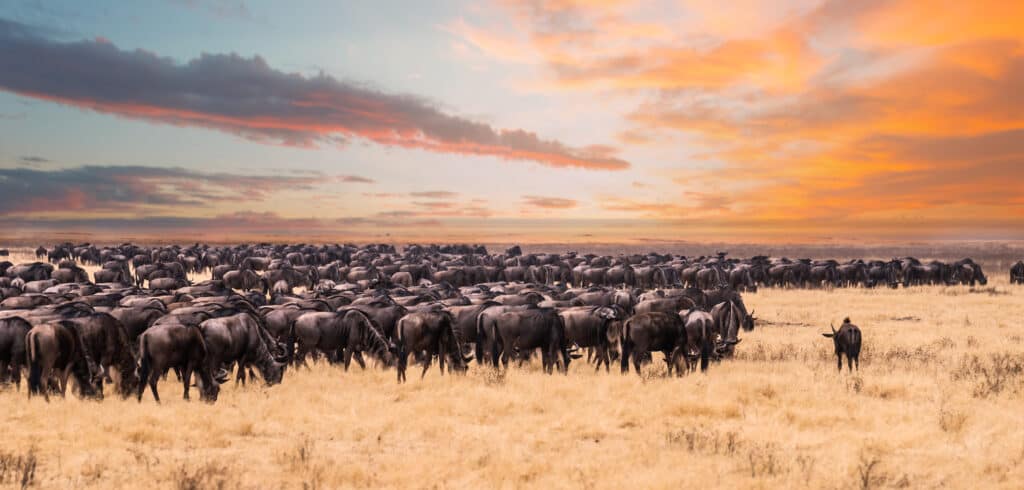Introduction: The Great Migration as an Incredible Natural Phenomenon
The Great Migration in Africa, as it is popularly known, is one of the most spectacular natural phenomena in the world. It is one of the seven natural wonders of Africa, and the world’s longest overland migration. Thousands of people make the journey to Tanzania and Kenya to witness the millions of animals make their journey across the enchanting African landscape. If you’ve ever wondered what exactly it is, or how you can see it for yourself, this is your complete guide to the Great Migration in Africa.
This is the greatest show on Earth. Every year, over 1.2 million wildebeest, 300,000 zebras, 470,000 gazelle, and thousands more topi migrate along a 1,000-mile-long route in a constant cycle through the Serengeti-Mara ecosystem to find green grass and fresh water. This enormous collection of animals attracts many predators and is truly a sight to behold.
The Route and Timing: Exploring the Migration Route and Seasonal Patterns of the Great Migration

A common sight along the Great Migration. Thousands of Zebra attempting to get a drink before pressing on.
©Mogens Trolle/Shutterstock.com
You might typically think of migrations as a group of birds flying from one point to another. The Great Migration is something much more impressive and happens all year long. Depending on what time of year you visit the migration route, the seemingly endless stream of animals will be in different places and doing different things along the migration path.
The migration is a natural phenomenon. It is driven by the seasons and the natural drive of the wildebeest, so it is impossible to predict with 100% accuracy. Typically, the herds try to make it to the northern portion of the migration route by the dry season, and then back south once the rains in the south have replenished the grasses enough for them to graze.
Keep in mind, that during what are considered “peak” seasons, when the largest numbers of animals are moving together, ticket and safari prices will get more expensive. But you will definitely be getting your money’s worth! However, no matter what time of year you visit the Great Migration, it will still be an unforgettable experience.
Winter and early spring season (January through March)
During this time, the herds will be spread out along the southern portion of the migration route. This is near the Ngorongoro Conservation Area. Most of the young will be birthed during this time.
Spring season (April through May)
After the young have gained enough strength to move on toward an area known as the Western Corridor. The herds will be moving through the Seronera and Moru Kopjes areas. Heavy rains, floods, and large storms make this a difficult time to see the Great Migration in action.
Summer season (June through July)
This is when one of the iconic events of the migration takes place: the crossing of the Grumeti River. There are many safari and tent options for watching the crossing. The herds will congregate together and attempt the crossing in large groups for safety. This is also the part of the migration where the animals will begin mating as they wait for their turn to dare the crossing.
Late summer and early fall season (August through October)
During this period, thousands of animals will cross from Serengeti National Park into the Maasai Mara Reserve. It is during this period when the herds will have to overcome their most difficult obstacle: the crossing of the Mara River. It is an unbelievable spectacle fraught with danger. Here you will have the opportunity to see the widest variety of wildlife and the most exciting event of the whole migration.
Fall and winter season (November through December)
After spending some time in the northern part of the migration, the herds will start the return trek south. They will pass through Loliondo. During this time, the rains on the southern Serengeti plains are raging, so the animals will attempt to arrive just as these rains are letting up, and the grasses are at their tallest. The animals who make it will give birth, and the cycle will begin again!
Wildlife Spectacle: Discovering the Diverse Wildlife Encountered during the Great Migration

African
buffalo
defending their herd against lions during the Great Migration.
©iStock.com/Mark Haeussler
The Great Migration attracts animals of all kinds along its journey. The main participants, wildebeest, zebra, gazelle, and topi, are tasty attractions for lions, hyenas, wild dogs, cheetahs, alligators, and other predators.
Beyond these main attractions, other animals that do not participate in the great migration are common sights along the routes, especially in Serengeti National Park or in the Ngorongoro Conservation Area. This includes over 70 species of large mammal (like the wildebeest or buffalo), 500 bird species, African bush elephants, black rhinoceroses, jackals, wolves, hippopotamuses, warthogs, baboons, different species of monkeys, pythons, cobras, ostrich, and more!
Challenges and Survival: Understanding the Obstacles Faced by Migrating Animals and Strategies for Survival

The Great Migration in Serengeti national park, Tanzania.
©iStock.com/MrRuj
Besides the dangers that such a long journey poses for the wildebeest, zebra, gazelle, and topi, there are three main challenges these migrants must face: predators, the Grumeti River crossing, and the Mara River crossing.
Of the millions of animals that participate in the Great Migration, over 250,000 wildebeests and 30,000 zebras alone will die from drowning, heat exhaustion, thirst and starvation, disease, or being caught by predators. Usually the weak, slow, and injured are the ones who are caught because the herds will leave them behind.
At the Gara and Grumeti river crossings, over 3,000 crocodiles wait every year to try their luck at catching an unlucky crosser. Many of them are successful. Additionally, whenever a crocodile attacks, it starts a panic among the other animals that are crossing the rivers, causing many to fall into deeper parts of the river or get injured. For every single wildebeest that is eaten by crocodiles, over 50 drown.
Experiencing the Great Migration: Tips for Witnessing and Enjoying this Extraordinary Event in Africa

Zebra and Wildebeest attempting the crossing of the Mara River together. There is safety in numbers.
©Arend van der Walt/Shutterstock.com
If you want to experience the Great Migration for yourself, there is substantial planning you must do. It is also not a cheap adventure.
First, you will want to decide when you want to go and what you want to see. This is not an amusement park, so the things you can see will change depending on the time of year. The peak season for witnessing the Great Migration is during the river crossing in the summer season. Prices will be at their highest at this time. However, the migration is still viewable throughout the year, so if you are traveling on a budget, don’t worry.
You should decide what kind of safari (if any) you want to do. There are safaris by jeep or truck, and also walking safaris. For each option, there are many companies that offer a wide variety of viewing options, amenities, and other benefits. If you have never traveled to Tanzania or Kenya before, we recommend sticking with the more well-known and reputable companies so you can be better prepared when you arrive.
Many safari companies have lodging as part of their travel packages. These are all usually in tents, so don’t expect to be staying in a hotel. You will be outdoors with the wildlife! You should definitely pick a few options and compare their lodging, safari, amenities, and price. The last thing you want is to pay a lot of money only to realize you didn’t quite get what you expected or wanted from your trip.
Thank you for reading! Have some feedback for us? Contact the AZ Animals editorial team.








